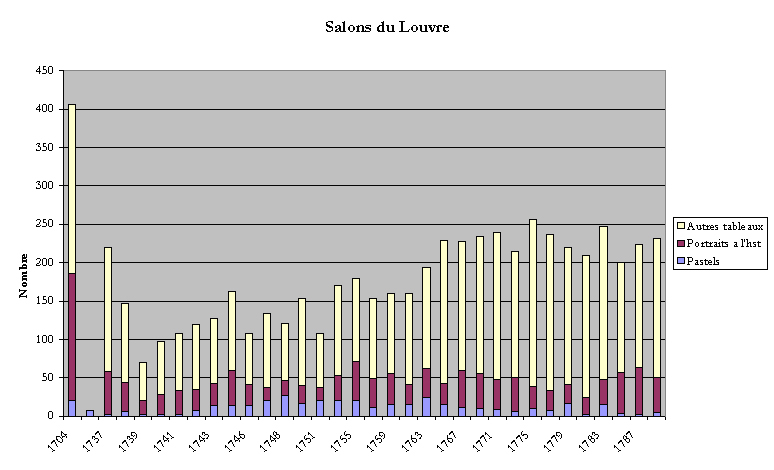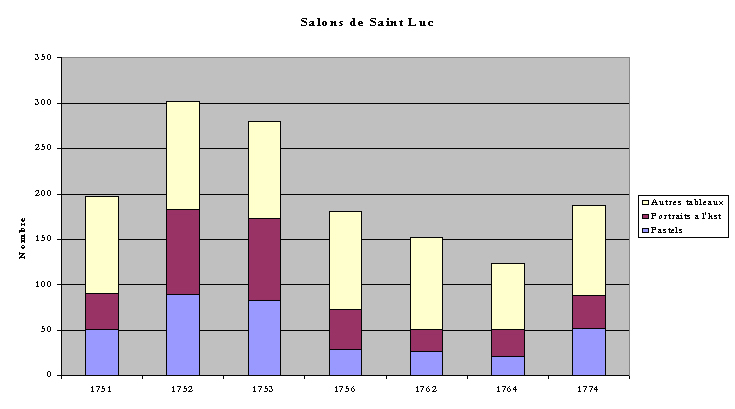|
HOME |
ABBREVIATIONS |
ARTISTS |
AUTHOR |
BIBLIOGRAPHY |
COLLECTORS |
ENGRAVERS |
GENEALOGIES |
MUSEUMS |
SEARCH |
SITTERS |
SUBJECTS |
Dictionary of pastellists before 1800
EXHIBITIONS
The files below cover the main exhibitions which included pastels, as well as bibliographic details of other exhibitions without pastels where the catalogue is referred to elsewhere in the Dictionary. Monographic exhibitions of a single artist's work (almost all post 1800) are identified by artist's name and date with full details in the relevant artist article (just above the bibliography); a summary list is linked below. All other exhibitions are cited by town and date (of the first appearance, in the case of travelling exhibitions); catalogue authors' or editors' names are cited where known, but not names of multiple authors. The order is by date; then alphabetically by town within each year. "Paris" is omitted from the references to the Paris exhibitions of the Académie royale (Salon du Louvre, or just Salon), the Académie de Saint-Luc (Salon de Saint-Luc), those held at the place Dauphine (Salon de la Jeunesse) and those organised by Pahin de la Blancherie (Salon de la Correspondance); "London" is omitted from exhibitions of the Royal Academy, the Free Society and the Society of Artists. The exhibitions before 1800 are accompanied by extracts from contemporary criticism which refer to pastels. Transcriptions are from the livrets of 18th century exhibitions (preserving the original spelling), and include items which are or appear to be pastels (the medium is not always specified, so a number of oil paintings may well have been included, and some pastels omitted). Where no livret was printed, or none has been found, a short list in the manner of a livret has been constructed from contemporary critiques. Apart from silent rearrangement of the sequence of some entries, editorial interventions are in square brackets, including cross-references to revised attributions or identifications where these are necessary to locate the works in the Dictionary, as well as annotations from commentators such as Mariette or Walpole. An asterisk against items in the Royal Academy catalogues indicates that they were for sale. In view of the bibliographic issues surrounding such sources, references are included both to the Collection Deloynes ("CD") and McWilliam, Schuster & Wrigley 1991 ("MSW").
In addition to the above files, illustrated livrets of certain exhibitions are being added to the site. Currently available are:
Exposition de Cent pastels (Paris 1908a)
Exposition de pastels français des XVIIe et XVIIIe siècles (Paris 1927a)
Just over 3000 pastels were exhibited in these public exhibitions during the eighteenth century, almost all during the second to fourth quarters. They may be summarised (with all necessary cautions arising from the incompleteness and ambiguity of the data) as follows:
5 years from | 1736 | 1741 | 1746 | 1751 | 1756 | 1761 | 1766 | 1771 | 1776 | 1781 | 1786 | 1791 | 1796 |
Louvre | 14 | 39 | 80 | 63 | 25 | 50 | 20 | 29 | 21 | 24 | 8 | 59 | 31 |
Paris other | 2 | 228 | 42 | 54 | 14 | 52 | 20 | 88 | 26 | 6 | 3 | ||
France regions | 18 | 23 | 16 | 61 | 141 | 47 | 38 | 52 | 5 | 1 | |||
London | 14 | 129 | 180 | 293 | 159 | 113 | 104 | 114 | 67 | ||||
Britain other | 4 | 28 | 57 | 31 | 10 | ||||||||
Germany | 13 | 5 | 9 | 135 | 68 | 94 | |||||||
Rest of world | 36 | 1 | 4 | 7 | 1 | 3 | |||||||
Totals | 50 | 40 | 82 | 309 | 104 | 253 | 320 | 577 | 285 | 282 | 326 | 255 | 196 |
Careful note should be taken of the distortions from various angles: regional salons (such as those in Dublin or Toulouse) were dominated by pupils' submissions, while others admitted the work of amateurs or children. The strictures against pastellists at the Académie royale were evident in the numbers of pastels shown there compared with the Académie de Saint-Luc. The suppression of that institution (only partially mitigated by the events such as the salons de la Correspondance), and the opening of the Louvre to non-academicians in 1791 - as well as the absence of public outlets in other countries before c.1760 are all significant. What nevertheless emerges from these numbers is the extent to which Paris led the wave of enthusiasm for pastel, followed after significant lags by Britain and then Germany.
Two further charts are helpful in demonstrating the significance of pastel compared with other forms of portraiture at the Paris exhibitions:

